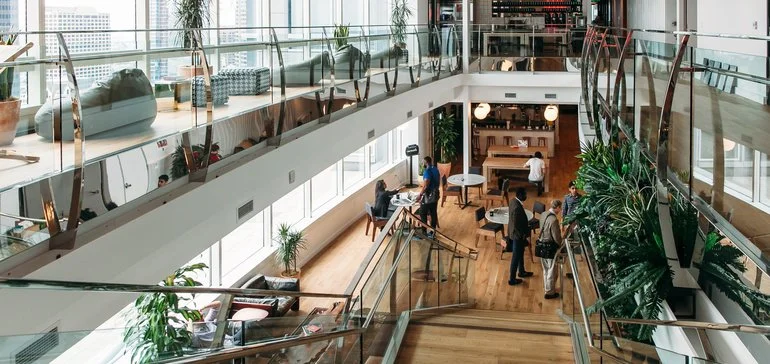Design contracts and new project inquiries reached their highest point in May, and have stayed in positive territory every month in 2017.
3D printing and Virtual Reality could reduce waste in design and construction says BCO
Digital technologies such as Virtual Reality (VR) and 3D printing could help reduce waste during a design and construction project, suggests a new report from the British Council for Offices (BCO). “Virtual Reality and 3D Printing – Reducing waste in office construction through new technology” reviews the existing applications of these technologies and their ability to mitigate waste during the design and construction process.
WeWork buys construction tech company
WeWork has scooped up FieldLens, a software application that helps various parties involved in a project — the developer, architect, construction manager, etc. — communicate in real time, Construction Dive reported. In a blog post, WeWork’s chief product officer David Fano noted that FieldLens will help the company manage millions of square feet of construction in the coming year.
MoMA Unveils Completed Renovation and Detailed Plans for Expansion
Thursday, New York’s Museum of Modern Art (MoMA) revealed the completed renovation of the east end of its campus, anchored by its original 1939 Philip Goodwin/Edward Durell Stone structure, now called the Lauder Building.
Canada Green Building Council and GBCI announce partnership to accelerate the mission of green building
New joint venture will deliver enhanced services and support a broad range of green business tools and programs throughout Canada.
When Net Positive is business plus
In a decade of working in sustainability, I’ve found that I usually face an uphill battle keeping the sustainable and energy-efficient features in building designs. Unless energy efficiency targets are mandated by law, the argument for sustainable features often comes down to doing the right thing for the planet and achieving a marketing advantage—both of which may be harder to justify for a commercial enterprise.
Architecture Billings Ease in April, but Remain in Positive Territory
The monthly Architecture Billings Index (ABI) came in at a score of 50.9 in April, down 3.4 points from March's 54.3, the AIA announced today.
Turner & Townsend: NYC has world's highest construction costs
Turner & Townsend's 2017 International Construction Market Survey (ICMS) names New York City as the metro with the world's highest costs of construction, at nearly $354 per square foot last year.
The New York City construction industry spent $43 billion in 2016, an outlay that was partly attributable to high wages of up to $100 per hour and that represents a 3.5% increase from 2015. Turner & Townsend predicted that the city will record another increase of 3.5% in 2017.
ConstructConnect: Nonresidential starts fall 7.2% in April
The value of April nonresidential construction starts fell 7.2% from April to March, veering sharply from the usual seasonal monthly bump of 12%, according to ConstructConnect.
The commercial category plummeted 35.4% month-over-month, but industrial was hit the hardest, tumbling 72% from March. The modest gains in heavy engineering (10.4%) and institutional (27.9%) were not enough to reverse the overall negative trend.
Q+A: How WeWork's construction team is using tech to scale up
WeWork may have gotten its start by giving entrepreneurs and other startups a formal — if funky — place to do business. But since the coworking space provider launched in 2010, it has expanded rapidly, both in its own footprint and in that of its clients. Just how big? WeWork, which has 140 locations in 44 cities worldwide, says 10% of its members today are Fortune 500 companies.
US Construction Spending Slipped 0.2% in March
U.S. builders trimmed construction spending slightly in March, one month after building activity hit an all-time high.
Construction spending slipped 0.2 percent in March to a seasonally adjusted $1.218 trillion , the Commerce Department reported Monday. In February, it rose 1.8 percent to a record high of $1.22 trillion . The result in March reflected drops in nonresidential construction and in the government sector, which offset a strong increase in residential activity.
Europe needs national renovation strategies for buildings, coalition claims
Europe must lead the world in cutting greenhouse gas emissions from existing buildings if it is to meet the ambitions of the Paris Agreement, claims BUILD UPON, a coalition of over 300 businesses and organisations from across the continent. The coalition – which includes cities, public authorities, property developers, manufacturers and energy utilities, as well as trade associations, NGOs and universities – is backing the need for ambitious ‘national renovation strategies’ that set out clear targets, milestones and measures on transforming existing buildings. The intervention comes as EU member states near the deadline to publish updated strategies to renovate their buildings, which account for around 36 percent of Europe’s total greenhouse gas emissions, and as political decision-makers grapple over the future of EU energy laws for the construction sector.
Office Market Swings in Tenants’ Favor
The U.S. office market became more tenant-friendly in the first quarter in many big cities as a seven-year expansion slowed.
Springy Bounce in ConstructConnect’s March Starts, +18%
Private office buildings’ was the largest subcomponent of commercial work in March (with a 26% share so far this year) and it struggled m/m (-59.6%) and y/y (-47.9%), but managed to cling to an advance y/y (+10.0%). ‘Hotel/motel’ starts claimed the second largest slice (18%) and they were a notable success: +48.2% m/m; +97.0% y/y; and +43.9% ytd.
ABI Growth Continues in March
The first quarter of the year ended on a positive note for the Architecture Billings Index (ABI). The American Institute of Architects (AIA) reported the March ABI score was 54.3, up from a score of 50.7 in the previous month. This score reflects a sizable increase in design services (any score above 50 indicates an increase in billings). The new projects inquiry index was 59.8, down from a reading of 61.5 the previous month, while the new design contracts index dipped from 54.7 to 52.3.
VIDEO: A San Francisco startup is 3D-printing entire houses in just one day
If you’re looking to move but can’t find the house of your dreams, you may be able to just print out what you’re after in the near future. A San Francisco-based 3D-printing startup, Apis Cor, has come up with an exceedingly affordable solution for building new houses. It can 3D-print concrete walls for a small house in under 24 hours.
WATCH: Disrupting the Construction Industry
Head of Research at Raymond James, Daryl Swetlishoff, speaks on the innovation of DIRTT a company completely disrupting the construction industry.
DIRTT Environmental Solutions (Doing it Right This Time) uses its proprietary 3D software to design, manufacture and install fully customized prefabricated interiors. The Company’s customers in the corporate, government, education and healthcare sectors benefit from DIRTT’s precise design and costing; rapid lead times with the highest levels of customization and flexibility; and faster, cleaner construction.
DIRTT’s manufacturing facilities are in Phoenix, Savannah, Kelowna and Calgary. DIRTT’s team supports more than 100 sales distribution partners throughout North America, the Middle East and Asia. DIRTT trades on the Toronto Stock Exchange under the symbol DRT.
This Company Will Design Your House For Less Than The Price Of Your Phone
Cover, a technology startup in Los Angeles, is bringing the design, engineering, and manufacturing of prefabs into the 21st century.
Wearable tech: The new tool for the modern construction workforce
From exoskeletons to augmented reality goggles, wearable tech is coming to construction sites – and helping to improve safety, efficiency and morale.
The wearable tech market is booming, with production set to hit 135 million in 2018. Smart and constantly connected, wearables include devices such as fitness trackers, smartwatches, and health monitors, with more functions emerging all the time.
Why Build Green? Lowered Operational Costs, Increased Staff Productivity and Higher Asset Values
Green building continues to play a growing role in the construction industry, with building industry professionals forecasting that more than 60 percent of their projects will be “green” by 2018.
Why build green? The survey found that green buildings offer significant operational cost savings compared with traditional buildings. Respondents — these include more than 1,000 survey participants from 69 countries — said they expect a 14 percent savings in operational costs over five-year savings for new green buildings and 13 percent savings in operational costs over five years for green retrofits and renovations.

























